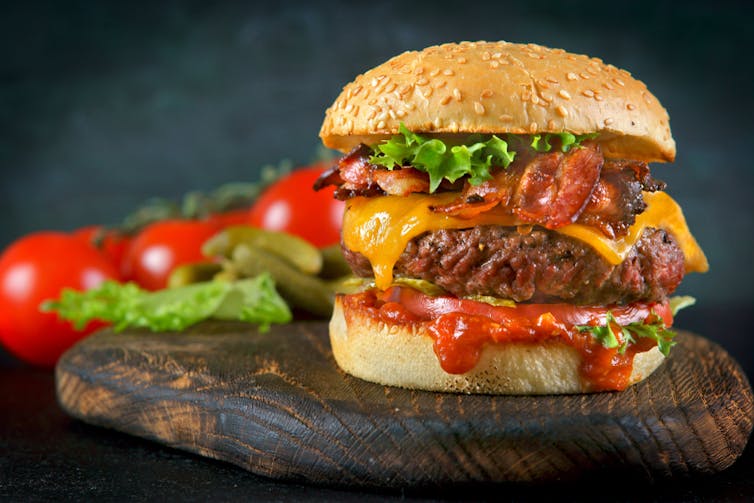
Guest post by: Dolly Theis, University of Cambridge
Would you eat a burger if you knew it contained almost 6,000 calories? Some would gladly tuck in while others would recoil in horror. But if you have calories on the menu, at least you know what you’re biting into. And as our latest research shows, menu labelling, as it is called, may be a powerful way to change the nation’s eating habits.
Research shows that the British public is increasingly eating out and ordering takeaways, rather than preparing food at home. Our earlier research estimates that a quarter of UK adults and a fifth of children eat at a restaurant or order a takeaway at least once a week. Food that isn’t prepared at home tends to be less healthy, more calorific and higher in fat, sugar and salt than food prepared at home. While eating out is a triumph for a large and important commercial sector, it is also contributing to the obesity crisis and the increase in diseases such as type 2 diabetes and cancer.
Still not mandatory
Unlike nutrition labelling on pre-packaged food, which has been around for years and mandated under EU law since 2016, menu labelling is still not mandated in the UK. The government included voluntary menu labelling in its Public Health Responsibility Deal in 2011, and several establishments have since introduced menu labelling.
Of the top 100 chain restaurants in the UK, we recently found that 42 publish nutritional information on their websites, and of these, 14 voluntarily provide menu labelling in their establishments. A proposal for mandated menu labelling was included in the UK government’s Childhood Obesity Plan, and a public consultation closed last December, but no announcement on a final policy has been made so far.
Mandatory menu labelling has been introduced in other countries, including the US in 2019 and parts of Australia.
Labelled menus mean healthier food
We found that food and drink sold at the top largest UK chain restaurants whose menus display energy information are lower in fat and salt than those of their competitors.
Menu labelling has often been touted as a way to provide information that helps people choose healthier dishes, but several reviews, including a recent Cochrane review, found only modest, poor quality evidence of an effect of menu labelling on purchasing and consumption. Our evidence suggests that the benefit of menu labelling may not necessarily be in helping consumers make healthier choices, but in incentivising restaurants to serve healthier food and drink. Without nutritional information, it is difficult to know where improvements are needed.
Nutritional information is only helpful if it is accurate. A 2018 study on the views of Irish food-service businesses towards voluntary menu labelling found that key barriers to implementing it included concerns about potential inaccuracies in calorie information and the lack of training on how best to provide quality calorie information.
If food outlets are mandated to provide menu labelling, they will need greater support and training to do so. But it may also increase the demand for more accurate, efficient and accessible methods of data collection (typically laboratory or electronic database analysis), promising easier ways to account for the nutritional quality of what’s on restaurant menus.
Should nanny stay at home?
Mandatory labelling will not be popular in all corners. After all, who doesn’t enjoy blowing out at the occasional all-you-can-eat buffet? The challenge is that eating out is not occasional anymore. It is has become habitual.
Fortunately, as we increasingly ditch the kitchen for the restaurant and takeaway, government has found that there is strong public support for menu labelling. Through the Childhood Obesity Plan, the government is exploring many ways to help make it easier for us all to make healthier choices and menu labelling should be considered as one of many policies, not as a silver bullet.
The 6,000-calorie burger is an extreme example. But think about it, when you last ate out, did you know how many calories you were consuming?![]()
Dolly Theis, PhD Candidate, University of Cambridge
This article is republished from The Conversation under a Creative Commons licence. Read the original article.
Read more: further reading on food from The Knowledge Exchange blog
Share
Related Posts
By Donna Gardiner While free school meals (FSM) have been available in England on a means-tested basis since 1944, recent years have seen a renewed focus upon the potential benefits of providing free school meals to all school-aged children. Currently, ....
Today sees the start of Community Garden Week 2023. Across the UK, communities will be celebrating the many and varied types of community gardens, from children’s and neighbourhood gardens to therapy gardens and allotments. The benefits of community gardens are ....
By Hollie Wilson At the start of 2020, an independent review was published setting out what needed to be done to bring about changes to the care system for children and young people in Scotland. At the heart of the ....
The “No Wrong Door” (NWD) programme means exactly that – there is no wrong door to turn to for young people seeking support. NWD works on several core principles, which include working with young people’s birth family or guardians, allowing ....
